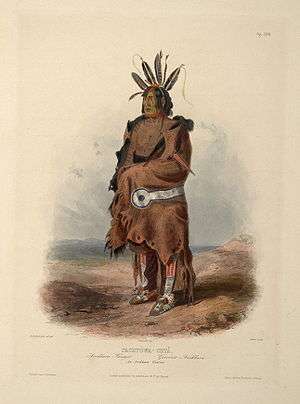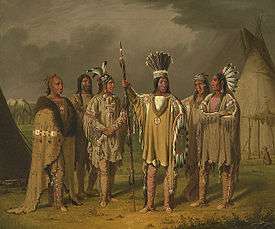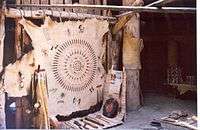Buffalo robe

A buffalo robe is a cured buffalo hide, with the hair left on. They were used as blankets, saddles or as trade items by the Aboriginal people of North America who inhabited the vast grasslands of the Interior Plains.[1] Some were painted with pictographs or Winter counts that depict important events such as epidemics, famines and battles.[2]
From the 1840s to the 1870s the great demand for buffalo robes in the commercial centres of Montreal, New York, St. Paul and St. Louis was a major factor that led to the near extinction of the species. The robes were used as blankets and padding in carriages and sleighs and were made into Buffalo coats.[3]
Only hides taken in winter between November and March when the furs are in their prime were suitable for buffalo robes.[1] The summer hides were used to make coverings for tipis and moccasins and had little value to traders and neither were the hides of bulls.[3][1]
Gallery
-

Chief Big Elk painted from life by George Catlin 1832 at Fort Leavenworth.
-

Karl Bodmer's portrait of an Arikara warrior wearing a beaded buffalo robe, early 1840s.
-

Six Blackfeet Chiefs - Paul Kane 1859
-

Hubert Vos- Sioux Chief In Buffalo Robes
-

Knife River Villages buffalo robe featuring the "Feathered Sun" motif, photo by Chris Light
-

1880 Commercially-made bison coat
See also
External links
References
- 1 2 3 William Waterston (1863). A Cyclopaedia of Commerce, Mercantile Law, Finance, Commercial Geography, and Navigation. H.G. Bohn. pp. 142–144.
- ↑ "Pictograph Robes of the Plains First Nations". Retrieved 2014-02-11.
- 1 2 John Welsted (1 January 1996). The Geography of Manitoba: Its Land and Its People. Univ. of Manitoba Press. p. 89. ISBN 978-0-88755-375-2.